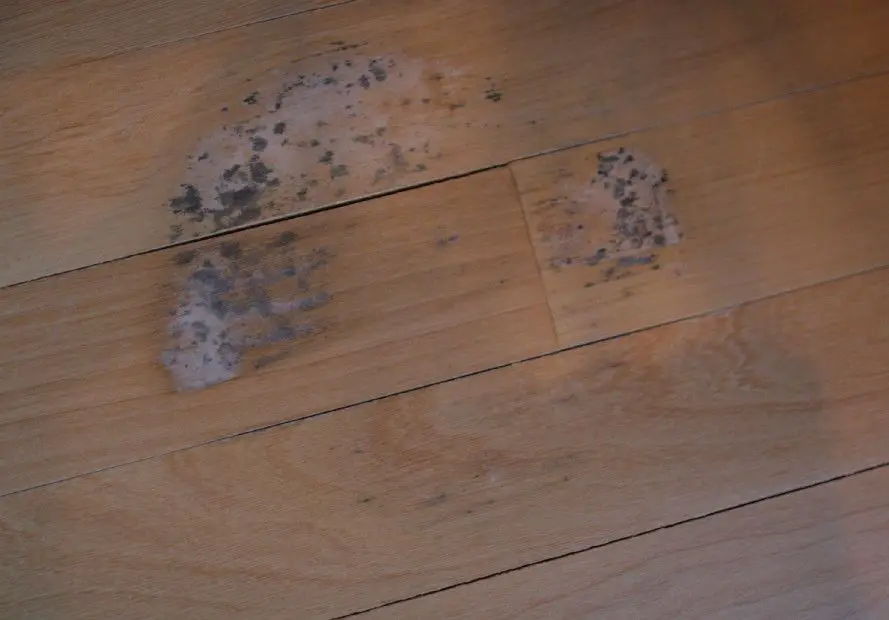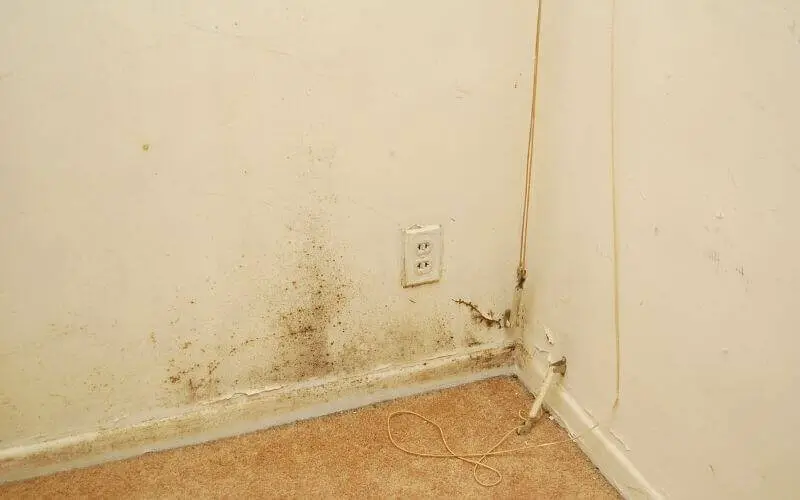Ever perceived a musty smell in your home? That’s one of the signs of mold under hardwood floors and there’s more. If moisture under hardwood floor is not tackled, this can lead to mold and eventually damage your floor.
Molds are various fungi that cover surfaces as fluffy mycelia and usually produce tons of asexual or sometimes sexual spores.
If you’re in a hurry and looking for an easy fix, then check out these mold foggers for getting rid of mold from your home: Best Mold Foggers
Mold is a growth of very small fungi forming on animal matter or vegetable, commonly as a downy or furry coating and associated with moisture or decay.
Mold can show in different colors on wood; it can be green, black, orange or yellow. Mold often discolors wood.
So I’m not surprised when people ask the question: can mold grow under hardwood floor?
Yes it can, mold attacks wood fibers and weakens them. This is what is responsible for wood rot and we’re going to discuss how to remove mold on hardwood floors.
There are more than a hundred thousand types of mold. When mold comes from water that stayed on hardwood for long, it is called stain fungi. This type of mold penetrates hardwood but not very deeply.
As the mold grows deeper into the hardwood, its color darkenes. When the mold darkens, it is usually called ‘blue stain’.
Mold that forms from chronic water in a leaky pipe is called decay fungi. Decay fungi’s spores do not stay on the surface of wood; they go inside the wood.
Hardwood flooring is a beautiful type of floor that connotes warmth, quality and the loveliness of nature. It is one of the ancient flooring materials, and it has been tested over time.
Moisture under hardwood floor can be very harmful. It will cause your hardwood to twist, warp and rot over time.
In this article, I will talk about moisture or mold under hardwood floors and how to get rid of it. Before we proceed, let’s see the causes mold under hardwood floors.
Read: Best Mold and Mildew Resistant exterior paint
Causes Of Mold Under Hardwood Floors
Table of Contents
Mold grows on organic materials that are in environments with trapped moisture or high humidity. This implies that hardwood floors are susceptible to mold growth beneath them in a case of flood or water damage.
Water damage does not have to be extreme before mold can grow. Unfortunately, you cannot do without spilling water on your hardwood floor in your home, as regular activities go on.
However, the best preventive measure is to avoid water on your hardwood floor for an extended period of time. This can be achieved with the aid of a Steam Mop or a Vacuum Cleaner.
You must mop and dry the water out immediately it spills to avoid white spots on hardwood floor.
Walking on your hardwood floor wet after a shower or from the pool, spilling from your pet’s water bowl and splashing water from your sink are scenarios that can trigger mold growth if unattended to.
At times, you can have too much moisture in your home without even noticing it. You can have mold spores and not have an idea of how they formed there. Also, there can be a leak in your home that you don’t know of.
Mold can be formed as a result of a defective water pipe, an open window bringing in humidity or a water heater leaking from the bottom. The dampest part of a house is usually the basement area. Basements are the part of a house that is likely to be flooded.
If you have wood floors in your basement, you have to be very careful to observe the moisture and prevent mold. If you have a dehumidifier that collects water in a room that has hardwood floors, make sure you empty it frequently so that the water will not overflow.
And also, if you have any live plants in your home and you overwater it to the extent that water gets to your hardwood floor without being cleaned up immediately, mold will form.
Read: Best Mop for Hardwood Floors
Signs Of Mould Under Hardwood Floors
Musty smells permeating your home area can be a sign that mold is growing somewhere. Mold usually oozes gases that have a musty odor. Find out more on what mold smells like.
Water damage is a prominent sign that there is a mold problem. If you observe spongy strength of the hardwood floor when you walk over it, it means water has damaged the wood and mold has surely grown.
Water stains on your floor is a sign that water has settled on your hardwood floor for long, hence, the formation of mold.
You can check under your hardwood floorboards for mold. You can do this yourself or call on a mold remediation specialist. Carefully pry up the trim so that you can pull up some hardwood floorboards.
While doing this, put on protective glasses and wear a face mask. Mold is toxic to human health; taking necessary precautions is a wise thing to do.
Read: Best Steam Mop for Hardwood Floors
How To Get Rid Of Mold Under Hardwood Floors
Materials needed:
- Respirator
- Gloves
- Goggles
- Long protective clothing or overalls
- Clean shoes
- Plastic sheeting
- Tape or nails and hammer
- Large garbage bags
- Box fan
- Pry bar
- Heat gun
- Chemical stripper
- Floor scraper
- 2 large buckets
- Spray bottle
- Borax
- Scrub brush or broom
- Dehumidifier
- Disposable rags
Having the materials close by, follow the steps below to get rid of mold under hardwood floors.
Read: Best Mold Foggers Review
1. Put clean shoes outside the room so that you can put in on when you move in and out of the room to avoid tracking mold across the floor of the house.
2. Remove furniture from the room. Move uncontaminated objects to an area that is free of mold. Put magazine racks and throw rugs that are contaminated with mold into a garbage bag. Seal the bags and take them outside immediately.
Items that are contaminated with mold and can be replaced easily should be thrown away. Put washable carpets, furniture, and clothes under the sun and attend to them after the house is treated.
3. Open windows to facilitate air circulation. Set a fan on the window, pointing outwards. Alternatively, put the fan on the floor and point it upward slightly (facing the window).
Do not let the fan blow directly on areas affected by mold. If mold is blown, more spores will be released, causing more damage.
4. Pry away baseboard wall trim in the infected area. Pull up any transitional floor trim that is in the room likewise. Remove the whole flooring in the room.
Or, if you think the mold infection is only in a small part of the floor and you want to patch only that area of the floor, remove only the trim needed to have access to the area of the floor involved plus two feet extra.
You might observe further evidence of the presence of mold, so, be prepared to remove more.
5. Gently rip up the floor; pay attention to the type and handle carefully. Begin at a corner of the room and pry up hardwood boards.
6. Meticulously observe your hardwood flooring. If you need to treat it, pile it up on one side and first focus on treating the subfloor.
7. In a large bucket, mix 1 cup of borax with 1 gallon of water. Pour the solution in a spray bottle to treat small areas. Or, work directly from the bucket if you have large areas to treat.
Dip a broom or brush into the borax solution, swab the liquid over the subfloor, and then wait for 15 minutes to allow the water some time to saturate the mold and weight it down so the spores will not be released.
Scrub the subfloor with the broom or brush before applying fresh solution again and waiting for another ten minutes. Scrub the floor for the last time.
At this stage, the borax solution has killed the mold and the scrubbing action has removed the mold from the subflooring.
8. If possible, vacuum over the subfloor with a vacuum cleaner. This will remove most of the dead mold. Or, make a new borax solution and wipe over the floor, again and again, using a disposable cloth.
We’ve written a review on the best vacuum cleaner, do check it out and make your choice.
Do not over-saturate the subfloor with moisture during the wiping stage; too much moisture creates a favorable environment for mold and can damage the hardwood subfloor.
Treat the hardwood floorboards removed in the same way described here.
9. Spray the subfloor and hardwood floorboards with a light layer of fresh borax water. Allow this treatment to dry out completely for a minimum of two days.
Turn up the heat and run a dehumidifier to facilitate swift drying. Once the hardwood is dry, the borax residue will continue to inhibit mold formation.
10. Treat items infected by mold with the borax solution.
11. Restore items to their initial position.
One of the best ways to clean your wood floors to get rid of moist is using cleaners like Pine Sol or Windex. Please check out the recommended posts below.
Additional Tips
Vinegar also gets rid of mold effectively. Experts generally don’t encourage using bleach for removing mold from hardwood floors, but if the home is flooded, bleach is the best disinfectant for the situation.
If the moisture and mold have rotted the subfloor or penetrated deeply enough to the extent of resisting removal, replace the subfloor. Saturate the material to weigh down the mold spores and then cut through the flooring using a reciprocating saw.
Bag and remove the affected part of the flooring. Fix fresh subflooring, cut to fit, with screws every 8 to 10 inches length along the floor joists.
Read: How to clean wood floor with vinegar
Precautions To Take
Put on an OSHA-approved particle mask or high-quality respirator along with gloves and protective clothing before you commence removal of mold from under your hardwood flooring.
Do not mix bleach with any other cleaning product because it can cause a very harsh chemical reaction.
Adhere to safety precautions. Large areas of mold are very toxic, so, professional removal is recommended, especially for people with health issues.
Even molds considered non-toxic can affect individuals with compromised immune systems, allergies or lung disease.
Must read: Best hover vacuum cleaner
Conclusion
Mold can be toxic to human health and the environment in general. If you come across these signs of mold under hardwood floors, don’t hesitate to tackle them as soon as possible.
Always clean spills on hardwood floors immediately and do well to check your house for any defects that can cause water leakage.
Over to you, have you come across mold on your hardwood floor? What method did you use in tackling it? Don’t forget to share this post with your friends, they would also be interested tackling molds under hardwood floor.


